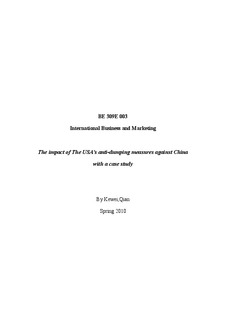| dc.description.abstract | The recent deepening of economic globalization and the associated trade liberalization
has reduced significantly the importance of tariff as a trade barrier. Anti-dumping
measures though can be implemented relatively easily and selectively compared to
other trade measure. Antidumping investigations, regardless of the final rulings, can
lead to almost immediate loss of market share on the part of exporting countries; they
have also become the most frequently use trade remedies. Since the start of financial
crisis, the trade protectionism started to germinate, particularly, anti-dumping measure
were frequently used
China has been the fastest growing economy for 30 years. Last year, China became
the world largest exporter. China’s economic relations with the United States
become more and more important to the world’s economic development. But, the
filings of contingent measures targeted at China have proliferated at a rapid pace, with
anti-dumping actions far more prevalent than other measures. Since 1994, China has
been the world’s number one anti-dumping target. The United States is (after India)
the country that has taken the largest numbers of anti-dumping initiatives against
China. So it is crucial to study the US’ anti-dumping activities against China.
This thesis discussed the reasons that United States of America is using anti-dumping
measures against China frequently. Further, I provide some countermeasures for
both Chinese government and firms to deal with anti-dumping investigations. A
case study, the Triangle Group, a major Chinese tire producer, is also provided. | en_US |
